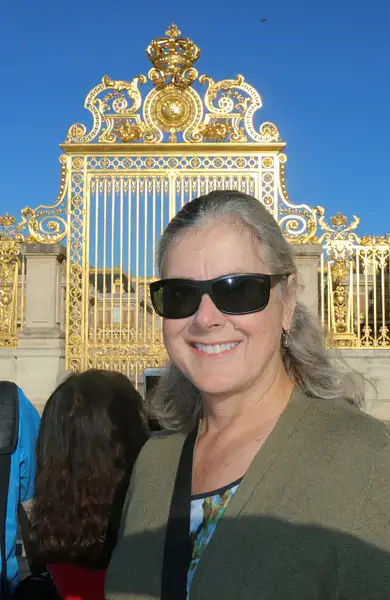


Queen Georgia at the Grand Trianon |
Grand Trianon interior |
The French Pavilion, Versailles
This pavilion is known as the “French” pavilion because it was located in the middle of one of those regular gardens which began to be known as “French” gardens in contrast with the budding trend of English gardens. Built by Gabriel in 1750, it was one of Louis XV’s first creations at Trianon, the estate to which he had felt drawn towards since childhood. It consists in a vast circular living room flanked by four small rooms used as a boudoir, warming room, kitchen and wardrobe. Accompanied by Madame de Pompadour the king would go there to relax, listen to music after his visits of the botanical garden or having enjoyed a light meal at the nearby Cool Pavilion.
|
Petit Trianon, Versailles
Petit Trianon, built between 1762 and 1768 during the reign of Louis XV, is a small château located on the grounds of the Palace of Versailles. It was designed by Ange-Jacques Gabriel by the order of Louis XV for his long-term mistress, Madame de Pompadour, and was constructed between 1762 and 1768. Madame de Pompadour died four years before its completion, and the Petit Trianon was subsequently occupied by her successor, Madame du Barry. Upon his accession to the throne in 1774, the 20-year-old Louis XVI gave the château and its surrounding park to his 19-year-old Queen Marie Antoinette for her exclusive use and enjoyment
|
The gardens of Petit Trianon |
The Temple of Love on the grounds of the Grand and Petit Trianon
This Temple of the Love, which the queen could see from her room in Petit Trianon, was erected by Richard Mique in 1778 in pure neo-classical style. Built entirely out of marble, this invaluable building is especially notable for the quality of the sculptures by Deschamps which adorn its Corinthian capitals, its friezes and the inside of its dome. This exceptional quality is explained by the fact that it was supposed to house a recognized masterpiece of French sculpture, Cupid cutting his bow from the Club of Hercules by Bouchardon whose original, now on display at the Louvre, was replaced by a replica by Mouchy, another great 18th century sculptor.
|
The grounds of Versailles |
The Belvedere Pavillion
Overlooking the lake, this charming eight-sided bandstand was built by Richard Mique in 1777. Outside, it is decorated with sculptures by Deschamps: a fruit frieze garland once painted with colours, pediments evoking the pleasures of hunting and gardening, window imposts symbolizing the four seasons. Inside, the circular living room is paved with a marble mosaic and its walls are adorned with fine ornaments.
|
Marlborough Tower, Versailles
This circular tower on the shores of the lake is mainly decorative. It was originally called “The Fishery Tower.” It was created after a popular lullaby from the era. The basement is used for storage, but the top part of the tower has a fairytale-esque design.
|
Marlborough Tower on the grounds of the Queen's Hamlet, Versailles
The Hameau de la Reine ("The Queen's hamlet") is the rustic retreat that was built for Marie Antoinette. It is situated in a secluded section of the Trianon gardens, within the park of Versailles, and adjoining the Petit Trianon, a small château.
|
The Queen's Hamlet
The Hameau de la Reine (The Queen's Hamlet) is a rustic retreat in the park of the Château de Versailles built for Marie Antoinette in 1783 near the Petit Trianon in the Yvelines. It served as a private meeting place for the Queen and her closest friends, a place of leisure. Designed by the Queen's favoured architect, Richard Mique and with the help of the painter Hubert Robert, it contained a meadowland with lakes and streams, a classical Temple of Love on an island with fragrant shrubs and flowers, an octagonal belvedere, with a neighbouring grotto and cascade. There are also various buildings in a rustic or vernacular style, inspired by Norman or Flemish design, situated around an irregular pond fed by a stream that turned the mill wheel
|
The Queen's Hamlet |
The Queen's House on the grounds of the Queen's Hamlet
This building is the most important building of the Hamlet. In fact, it is composed of two separate buildings joined by a wooden gallery, decorated with white and blue earthenware flowerpots with Marie-Antoinette’s monogram. On the right, the Queen’s House itself, the ground floor comprised of a dining room and a games room, while the first floor was made up of a large living room, a small living room and a Chinese room; on the left, the Billiard Room, the ground floor comprised of a billiard room, and a private apartment on the first floor. From the top of the gallery, the lady of Trianon, wearing a simple white muslin dress and a straw hat, could oversee the work being done in the fields.
|
Tom at the Mill on Marie Antoinette's retreat |
Marlborough Tower, The Queen's Hamlet, Versailles
The Marlborough Tower was used as an observatory and from the top of the tower it was possible to communicate with the palace through light signals! It was from here that the boat-rides would take off; ever since Louis XIV's time it had been popular to go on boat rides along the canals in the park and some courtiers even had their own boats. The royal family's fishing equipment was stored here as well.
|